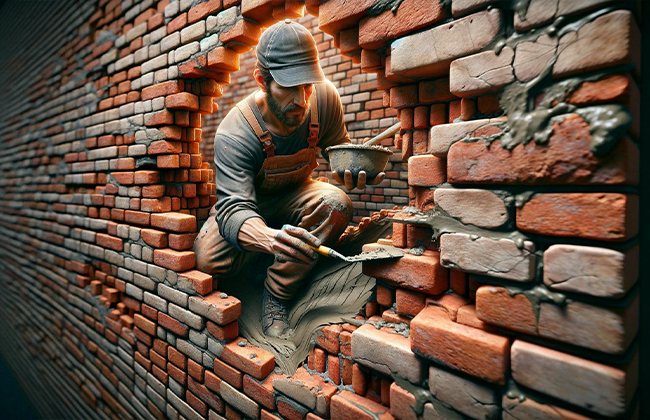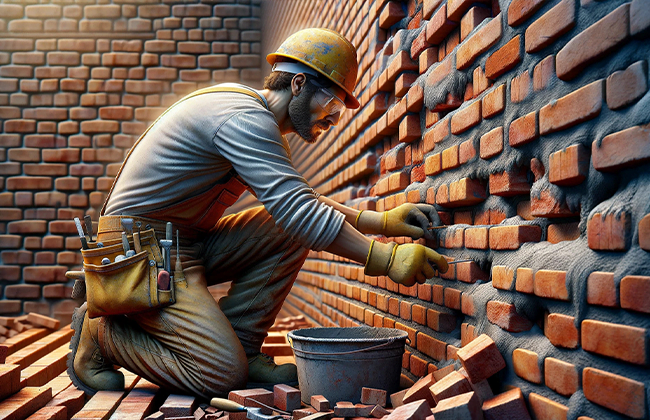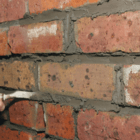Brick crack repair is a crucial aspect of maintaining the structural integrity and aesthetic appeal of brick structures. In this comprehensive guide, we’ll explore various methods and strategies to effectively address brick cracks. From understanding the root causes to employing the right repair techniques, this article aims to equip homeowners with the knowledge needed for successful brick crack repair. Emphasizing safety, detailed instructions, and regular maintenance, this guide is your go-to resource for all things related to brick crack repair, ensuring your brickwork remains in pristine condition.
Table of Contents
Understanding Brick Crack Formation
Understanding why bricks crack is pivotal in preventing and repairing damage effectively. This section delves into the common causes of brick cracks, such as thermal expansion and contraction, moisture issues, and structural movement. Grasping these factors helps in diagnosing and addressing brick crack issues accurately.
How and Why Do Bricks Crack?
Bricks are a fundamental component of many buildings, valued for their durability and aesthetic appeal. However, they are not impervious to damage, and cracking is a common issue that homeowners face. Understanding the causes of these cracks is key to effective prevention and repair.
- Thermal Expansion and Contraction: One of the primary reasons for brick cracks is the natural thermal expansion and contraction that occurs with temperature changes. As the temperature rises, bricks expand, and as it falls, they contract. This continuous cycle of expansion and contraction can cause stress on the bricks, leading to the formation of cracks. This is particularly evident in climates with significant temperature fluctuations.
- Moisture Issues: Water plays a significant role in brick deterioration. Bricks are porous, meaning they can absorb water. This absorption can be detrimental in several ways. First, during freezing conditions, any water trapped inside the brick can freeze, expand, and cause the brick to crack. Secondly, excessive moisture can weaken the mortar, the material that holds the bricks together, leading to cracks and even the collapse of brick sections.
- Structural Movement: Buildings naturally settle over time, and this movement can place stress on the brickwork. Additionally, seismic activity, heavy traffic nearby, or construction work can cause vibrations that affect the structure’s integrity. These movements can result in different types of cracks in the brickwork.
Identifying Different Types of Cracks
Recognizing the type of crack in your brickwork is crucial for determining the most effective repair strategy.
- Hairline Cracks: These are thin, superficial cracks that usually don’t pose a threat to the structural integrity of the building. They are often caused by minor settlement or slight shifts in the building’s structure. Despite being non-structural, they should be addressed to prevent water infiltration and potential worsening.
- Stair-Step Cracks: These cracks follow the mortar joints in a zigzag pattern resembling the steps of a staircase. They are often indicative of a more significant issue, such as foundation settlement or movement. If these cracks are widening or accompanied by other signs of foundation issues, it’s essential to seek professional advice.
- Horizontal Cracks: Horizontal cracks are a major concern and often indicate severe structural problems. They can be caused by lateral pressure on the wall, possibly due to soil expansion or heavy loads on the wall. These cracks require immediate attention from a structural engineer.
Preparation for Brick Crack Repair
Before starting any repair process, it’s essential to be well-prepared. This section covers the safety precautions to consider and lists the necessary tools and materials for brick crack repair. From protective gear to the right selection of tools, proper preparation ensures a safer and more effective repair process.
Safety Precautions
Before embarking on any repair work, it’s critical to prioritize safety. Always wear protective gear, including sturdy gloves to protect your hands from sharp edges, safety goggles to shield your eyes from dust and debris, and a dust mask to prevent inhalation of fine particles.
Tools and Materials
You will need a few essential tools and materials for brick crack repair:
- Chisel and Hammer: These are used to remove loose or damaged mortar from around the crack.
- Wire Brush: A wire brush is essential for cleaning out the crack and ensuring that the new mortar or caulk adheres properly.
- Masonry Mortar: This will be used to refill larger cracks and gaps in the brickwork.
- Caulking Gun and Masonry Caulk: For smaller, hairline cracks, masonry caulk is an effective solution.
Step-by-Step Guide to Brick Crack Repair
Repairing brick cracks can seem daunting, but with the right guidance, it’s a manageable task. This section provides a comprehensive, step-by-step guide to repairing different types of brick cracks. From cleaning the cracked area to applying the correct repair method, these instructions aim to help homeowners undertake brick repairs with confidence.
Cleaning the Crack
- Remove Loose Mortar: Use the chisel and hammer to gently remove any loose or damaged mortar around the crack. Be careful not to cause further damage to the surrounding bricks.
- Clean the Area: Once the loose material is removed, use the wire brush to thoroughly clean the crack and surrounding area. This will help the new material to bond effectively with the old.
Repairing Minor Cracks
- Apply Masonry Caulk: For hairline cracks, masonry caulk is an effective repair material. Load the caulk into the caulking gun and apply it along the crack, making sure to fill it completely.
- Smooth the Caulk: Use a putty knife or your finger to smooth out the caulk. This not only improves the appearance but also ensures a good seal.
Repairing Larger Cracks
- Prepare the Mortar Mix: Follow the manufacturer’s instructions to prepare the masonry mortar. The mix should have a consistent, workable texture.
- Fill the Crack: Carefully apply the mortar into the crack using a trowel. Make sure the mortar is pushed deep into the crack to create a strong bond.
Curing and Finishing
- Allow the Mortar to Cure: Leave the mortar to dry as per the recommended time. This could vary based on weather conditions and the type of mortar used.
- Match the Repaired Area: Once the mortar is cured, you can apply a finish to match the repaired area with the surrounding brickwork. This might involve painting or applying a sealant.
Maintaining Your Brickwork

Regular maintenance is key to prolonging the life of brickwork and preventing significant damage. This section emphasizes the importance of regular inspections, cleaning practices, and sealing techniques. Learn how to keep your brickwork in top condition, preventing future cracks and other related issues.
Regular Inspection
To prevent small cracks from becoming major issues, regularly inspect your brickwork. Look for any signs of damage, especially after extreme weather conditions.
Cleaning and Sealing
Regular cleaning of your brickwork can prevent the buildup of dirt and grime, which can retain moisture and lead to damage. Additionally, applying a sealant to the bricks can help to repel water and reduce the risk of cracks forming.
Conclusion:
In conclusion, effective brick crack repair is integral to preserving and extending the lifespan of brick structures. This article has provided detailed insights into identifying, preparing for, and executing brick crack repair, along with essential maintenance tips. By understanding the causes, following the step-by-step repair guide, and adhering to regular maintenance practices, homeowners can ensure their brickwork remains robust and visually appealing. Remember, you should always seek professional help for complex issues, as DIY methods are effective only for minor repairs, to maintain the safety and integrity of your brickwork.
FAQs
Q: What are the common causes of brick crack repair needs?
A: The need for brick crack repair often arises from thermal expansion, moisture infiltration, and structural movements. These factors cause different types of cracks, requiring timely and appropriate repairs.
Q: Can DIY brick crack repair methods be effective?
A: Yes, DIY brick crack repair can be effective for minor issues like hairline or small cracks. However, for larger or structurally significant cracks, it’s advisable to consult a professional.
Q: How often should I inspect my home for brick crack repair?
A: Regular inspections, ideally twice a year, can help in early detection and repair of brick cracks, preventing them from worsening and causing more extensive damage.
Q: What is the best time to perform brick crack repair?
A: Brick crack repair is best done in mild, dry weather conditions. Extreme temperatures or humidity can affect the curing process of the repair materials.
Q: Is it necessary to match the mortar color in brick crack repair?
A: Matching the mortar color during brick crack repair is important for aesthetic reasons. It ensures a seamless and visually appealing finish to the repaired brickwork.




